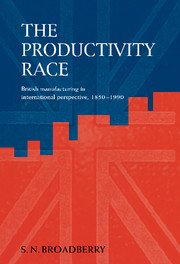Book contents
- Frontmatter
- Contents
- List of figures
- List of tables
- Acknowledgements
- Glossary of terms and company names
- 1 Introduction and overview
- Part 1 measuring comparative productivity performance
- Part 2 explaining compartive productivity performence
- Part 3 reassessing the performance of British industry
- 10 The rise of competition from abroad, 1850–1914
- 11 War and depression, 1914–1950
- 12 Changing markets and technology, 1950–1990
- 13 Concluding comments
- Bibliography
- Index
13 - Concluding comments
Published online by Cambridge University Press: 28 October 2009
- Frontmatter
- Contents
- List of figures
- List of tables
- Acknowledgements
- Glossary of terms and company names
- 1 Introduction and overview
- Part 1 measuring comparative productivity performance
- Part 2 explaining compartive productivity performence
- Part 3 reassessing the performance of British industry
- 10 The rise of competition from abroad, 1850–1914
- 11 War and depression, 1914–1950
- 12 Changing markets and technology, 1950–1990
- 13 Concluding comments
- Bibliography
- Index
Summary
Overview
Part 1 of this book is concerned with setting out quantitatively the patterns of productivity performance in manufacturing for Britain compared with the United States and Germany. Whereas at the whole economy level there has been a substantial relative decline in Britain's labour productivity performance since the mid-nineteenth century, in manufacturing comparative labour productivity levels have remained stationary. Labour productivity in US manufacturing has fluctuated around a level of about twice the British level, while German manufacturing labour productivity has fluctuated around a level broadly the same as the British level. British relative economic decline cannot therefore be explained in terms of a deteriorating relative labour productivity performance in manufacturing, but must rather be due to trends in other sectors and the effects of structural change.
Part 2 of the book sets out to explain the persistent labour productivity gap in manufacturing between the United States on the one hand and Britain and Germany on the other. This is explained largely in terms of the parallel development of national technological systems, geared to local demand conditions and to resource and factor endowments. The origins of the gap lie in the abundance of land and natural resources in America compared with Europe. During much of the nineteenth century, technological leadership rested with British flexible production methods, producing customised output with skilled shopfloor labour. American manufacturers adapted these methods to local circumstances, economising on scarce skilled labour but utilising abundant natural resources. This led to the development of a distinctive American machine-intensive and resourceusing technology that economised on skilled shopfloor labour.
- Type
- Chapter
- Information
- The Productivity RaceBritish Manufacturing in International Perspective, 1850–1990, pp. 395 - 399Publisher: Cambridge University PressPrint publication year: 1997



